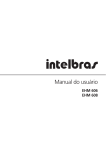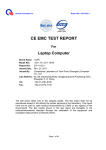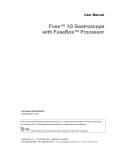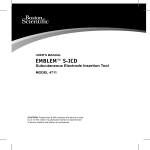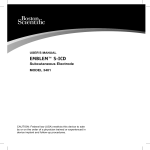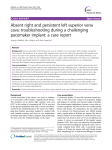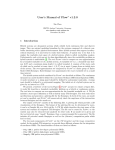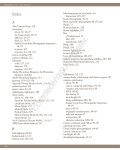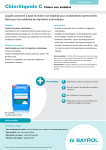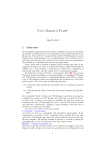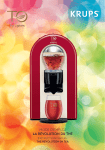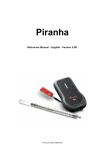Download Image optimization: you are the artist Kathryn E Glas, MD, FASE
Transcript
Image optimization: you are the artist Kathryn E Glas, MD, FASE, MBA 17th Annual Echo Week Objectives: 1. Describe probe manipulations necessary to optimize an image 2. Explain the use of settings to optimize imaging 3. Describe the optimal use of color-flow Doppler to recognize anatomic and pathologic findings TEE images shown in lectures, articles and guidelines publications show perfect examples of the stated view. The individual providing the image likely went to great lengths to find an example that perfectly met the criteria. Remember from first year anatomy class in medical school that there really is no such thing as normal, and variants can be as common as normals. The goal of this discussion is not only to show how to improve images, but also provide a sense of when ‘the enemy of good is better’. In performing a TEE examination, the goal is to obtain an image that allows evaluation of the anatomic structure in question, understanding that the angle of obtaining such information may not be within the range recommended by guidelines documents. Alternatively, patient status may preclude the amount of probe flexion necessary to show the entire left ventricular apex during a mid esophageal (ME) evaluation and apical imaging may be limited to gastric views. The first figure shown lists the probe manipulations available with TEE. The esophagus is directly behind the heart and we use the left atrium as our imaging window. Unlike transthoracic (TTE) exams, we cannot move the probe across the chest wall to change our views- we can only move within the confines of the esophagus. Fortunately we can obtain almost all of the information seen on TTE and importantly better viewing of some items as well (mitral valve). Most individuals start their examination at the 4chamber view. This both allows a rapid assessment of global status but also sets up a rapid assessment of the LV, MV and AV structures with a single omniplane rotation. Rotation of the omni plane angle does not actually rotate the probe, it rotates the angle of the transducer array inside the probe. Taking time to align your image in the 4 chamber view will aid your ability to visualize the LV views in the ME. The rotation axis of the omniplane originates at the transducer. If the apex of the LV is aligned with this point in the 4chamber, then the apex will remain in view and will not be foreshortened as you rotate. Keep in mind that small, even minute, manipulations can create an improvement in the image. Don’t focus on the ominplane angle number, look at the image and advance slowly until you see the structures key to any given view- both papillary musles in the midcommissural or a single papillary muscle and the left atrial appendage in the 2chamber. Slight ante- or retroflexion of the probe can improve contact with the heart or add the small angulation difference necessary to see both the MV and the LV apex in the ME views. Flexing to the left or right is helpful when the heart position has been altered in relation to the esophagus- an enlarged ascending aorta or descending aorta, for example. There are two caveats here: first, large aneurysms can, in theory, rupture with excessive force applied by a probe and second, moving the probe in the locked position increases the risk of esophageal injury. It is strongly recommended that the probe not be locked when manipulations are performed on anesthetized patients. Figure 2 shows the conventions of image display associated with TEE. Dextrocardia cannot be diagnosed without adherence to the conventions. In LAX, the aorta and IVC at 90 degrees follow this relationship, with the head of the patient to the right of the display and the foot of the paitent to the left. There are numerous pre and post processing manipulations that can be effective in improving image quality. Adjustments to gain, compress, TGC, depth of image, width of image, zoom function, grey scale, probe mHz, addition of harmonics, Nyquist limit of color doppler, baseline and scale of spectral doppler displays. Some machines now have a single button that auto adjusts gain and compress. While this is frequently adequate, additional adjustments are sometimes indicated. Consult the user manual specific to your equipment will provide helpful information on machine controls and image optimization techniques. Gain- Controls the total gain of the active mode, be it gray scale in 2D or total gain of spectral doppler modes TGC-time gain compensation adjusts for depth-related attenuation of the image, with each knob adjusting a different depth. The uppermost knob adjusts the image at the top of the image. Depth- controls the displayed depth of image display. Most TEE imaging can be accomplished between 8 and 15 cm depth. 8-10 cm is optimal for mitral valve imaging and 15 cm +/- for ME views including the LV, with greater depth needed for larger hearts. Zoom- allows selection of a small segment of the image to be magnified and limits the image display to that small portion of interest. Refe erence: Hahn n RT, Abrah ham T, Ada ams MS, Brruce CJ, Gllas KE, Lan ng RM, Ree eves ST, Shan newise JS, Siu SC, Ste ewart W, Picard P MH; A American S Society of Echo ocardiograp phy; Society y of Cardiov vascular An nesthesiolo ogists. Guid delines for perfo orming a co omprehensive transeso ophageal e echocardiog graphic exa amination: recom mmendatio ons from the e American Society off Echocardio ography an nd the Socie ety of Cardiovascular Anesthesio ologists. An nesth Analg g. 2014 Jan; 118(1):2168. http:///pie.med.u utoronto.ca//TEE/TEE_ _content/TE EE_probeMa anipulation_intro.html




